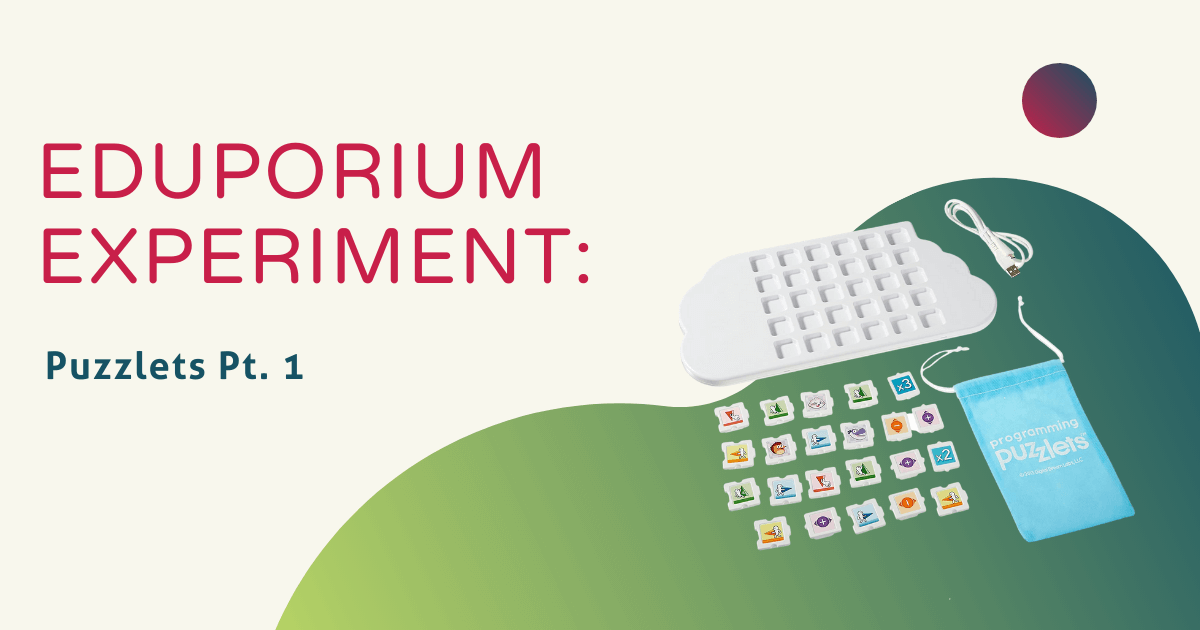Puzzlets is a unique product designed to introduce the youngest students to problem solving and inspire curiosity through technology. The Puzzlets themselves come in a kit that connects to a Bluetooth-enabled device and create the conditions for an unusual kind of play: an interactive video game controlled by a group of physical toys rather than the controller-based or touch-screen interaction that the world of video gaming is so accustomed to. There is currently one game available for the Puzzlets platform with two more in development and the potential for many more.
These games aim to help young children learn logic, math, cause-and-effect, sequences, and so much more. The current game teaches basic coding skills, like the idea of putting commands together before starting a task, and the two upcoming games are designed to teach math and color theory, respectively. The games are ideal for introducing these subjects to children aged 6-10, with younger kids also able to enjoy them with parental help.
So, naturally, who better to give it a test run than two twenty-something Eduporium employees? My co-worker and I sat down in our conference room with a fully charged Puzzlets Play Tray, a set of Puzzlets, and a phone loaded with the “Cork the Volcano” Puzzlets game app. We sorted out our Puzzlets and got ready to dive in. There are Puzzlets pieces that represent commands for moving in certain directions (up, down, left, and right), plus and minus signs, Puzzlets to switch characters, and multipliers for doubling or tripling values. We took a good look at all of the pieces, signed in to the app—which only requires a name (the “age” and “parent’s email” fields are optional), and started playing right away.
The game starts off rather easily, first teaching that when you put the ‘right’ arrow on the Play Tray then hit the “Start” button on the screen, your character moves to the right. Next, it provides a second tutorial explaining that, when used similarly, the left arrow moves the character to the left. The game then shows kids how to combine these two movements into a sequence of walking one way then walking the other for the character to gradually make its way to the bottom of a twisty little pit. Next, it introduces jumping with the “Up” Puzzlet, and the levels get a little bit more complicated, as we had to think about timing our little dinosaur character’s jumps along with his turns.
After a little while more, we met Rus’s (our character) friend, Hippo, who is—surprise—a hedgehog, and, true to video game fashion, we were now thinking about when to use the tall Rus (who walks over small holes) or the tiny Hippo (who fits inside them) based on what we needed to accomplish in different levels. Each group of levels ends in a boss challenge, in which a large monstrous-looking character tries to stop the character from reaching its goal by throwing things, thereby testing all the skills kids have learned up to that point. We played through the first two worlds of the game and were pleasantly surprised by what we found in this little package.
Overall, we found this to be a very kid-friendly game, from the cute, brightly-colored graphics to the cheerful music that played throughout. The challenge of it was a bit lost on us, as we’re older than the target audience, but we agree that Puzzlets’ style and approach to coding would be fantastic for young children who are still new to electronic games and coding. Overall, Cork the Volcano provided a very solid experience that left us optimistic about what’s still to come from Puzzlets.
If you have any suggestions for products you’d like to see featured on the Eduporium Experiment, let us know! Comment below or send us a message on Twitter or Facebook! Click below to shop!



